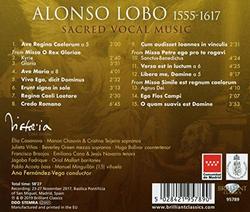| All Artists: Coro Victoria Title: Lobo: Sacred Vocal Music Members Wishing: 0 Total Copies: 0 Label: Brilliant Classics Release Date: 2/1/2019 Genres: Opera & Classical Vocal, Classical Styles: Vocal Non-Opera, Requiems Number of Discs: 1 SwapaCD Credits: 1 |
Search - Coro Victoria :: Lobo: Sacred Vocal Music
 | Coro Victoria Lobo: Sacred Vocal Music Genres: Opera & Classical Vocal, Classical On this new recording, Coro Victoria offers a portrait of Alonso Lobo (1555-1617) through a cross-section of his sacred output (his works in Spanish are all lost). The group also illustrates the variety of interpretative p... more » |
Larger Image |
CD Details
Synopsis
Product Description
On this new recording, Coro Victoria offers a portrait of Alonso Lobo (1555-1617) through a cross-section of his sacred output (his works in Spanish are all lost). The group also illustrates the variety of interpretative practices of the period. The concluding O quam suavis est Domine is sung by a single soprano while the vihuela accompaniment supplies the remaining five parts. Church choirs sang this music in the liturgy, but minstrels also played it during processions, and there was free traffic between sacred and secular contexts. Coro Victoria was founded by its director, Ana Fernández-Vega, to recover and preserve a native, historically informed tradition of singing Spanish polyphony from its Renaissance-era high noon, exemplified not only by Victoria himself but also his contemporaries such as the Seville-born and bred Alonso Lobo (indeed, Victoria considered Lobo his equal). He is now best known for a haunting, six-voice setting of the Requiem, and his magnificent motet for the obsequies of King Philip II, Versa est in luctum shares the Requiems tone of mourning and remembrance, established by a dense mesh of overlapping counterpoint. Coro Victoria also presents other sides to a composer whose style is far more various than is commonly assumed. As well as the beautifully handled techniques of canon and counterpoint in Marian motets such as Ave Maria and Ave Regina coelorum, distinguishing features of Lobos style are his jagged melodic lines, a far cry from Palestrinas smooth curves, and his more animated conclusions, both vividly demonstrated by Vivo ego, dicit Dominus. There is also a complete, portmanteau setting of the Mass, drawn from his Missa O Rex gloriae, Missa Petre ego pro te rogavi and Missa Simile est regnum caelorum, with the Credo filled in by the separate Credo Romano, which is underpinned by a figured bass and continued to be popular long after his death. These polished performances should renew wider interest in Lobos music.
